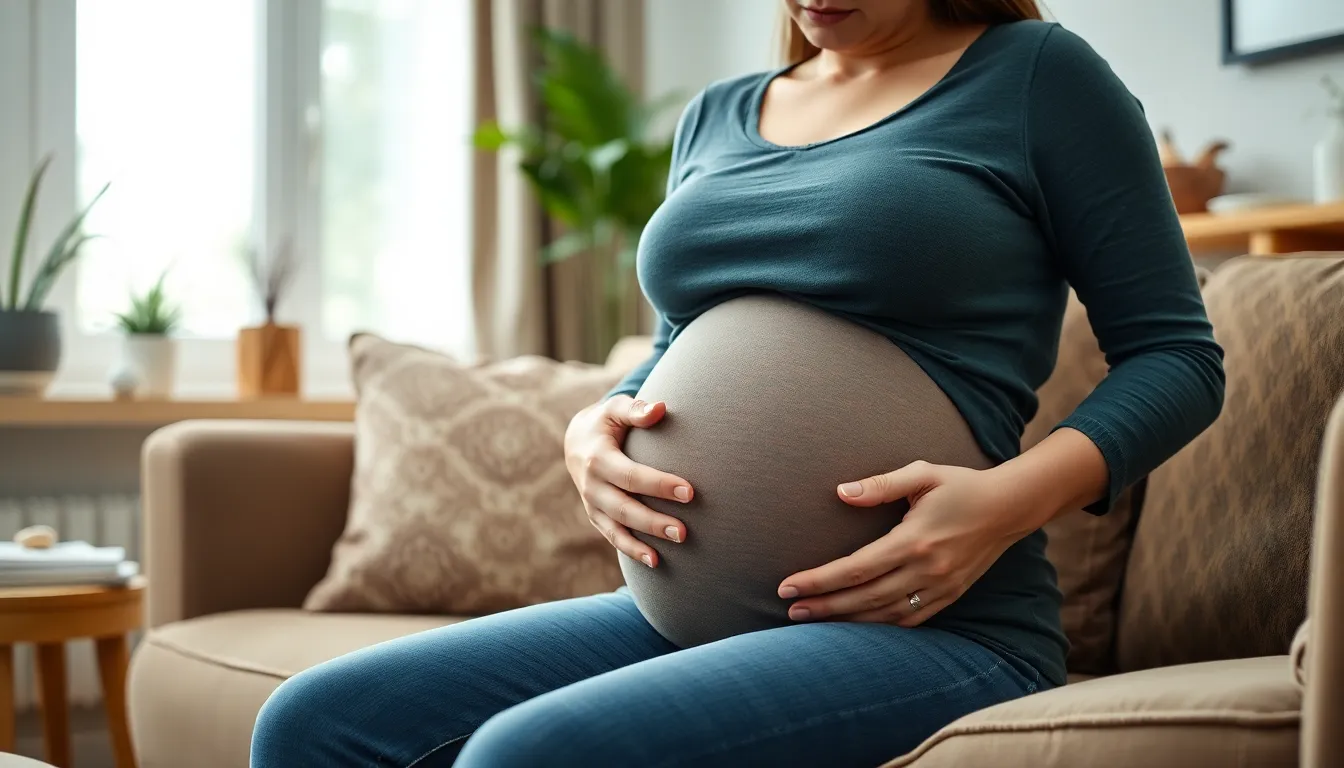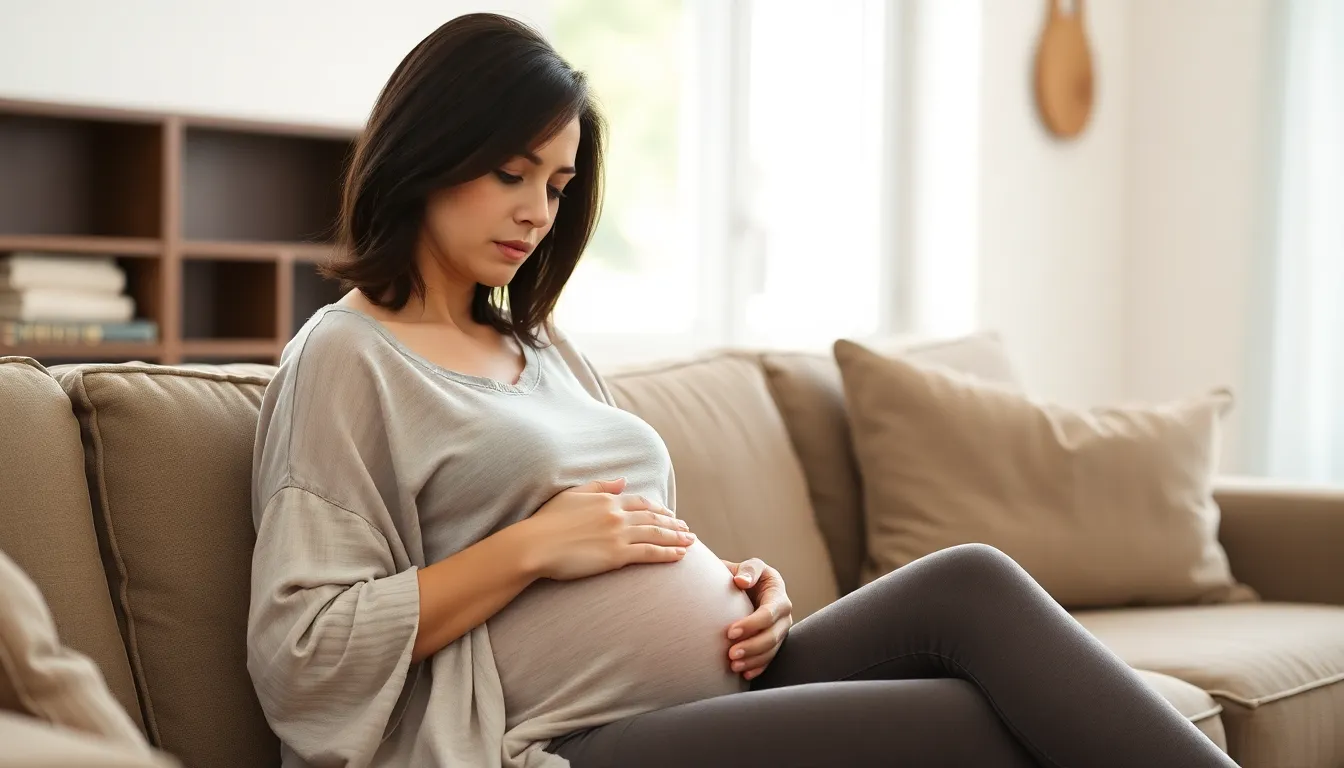As the third trimester unfolds, many expectant mothers experience a range of physical changes, including period-like cramps. While it’s common to feel some discomfort, understanding the nature of these cramps is crucial for reassurance and well-being.
These sensations can often be attributed to the body’s preparation for labor, hormonal fluctuations, or even the stretching of ligaments. However, distinguishing between normal discomfort and potential warning signs is vital. By recognizing the difference, mothers can navigate this final stretch of pregnancy with confidence and peace of mind.
Table of Contents
ToggleUnderstanding Period Cramps During Pregnancy
Expectant mothers may experience period-like cramps during the third trimester. Recognizing the reasons for these sensations is crucial for understanding the body’s preparation for labor and overall pregnancy health.
Causes of Cramps in the Third Trimester
- Braxton Hicks Contractions: These irregular contractions occur as the body prepares for labor. They might feel similar to menstrual cramps, often fading with movement or hydration.
- Hormonal Changes: Fluctuations in hormones, particularly prostaglandins, may contribute to cramping. These hormones play a significant role in regulating the body and preparing the uterus for delivery.
- Round Ligament Stretching: As the uterus expands, ligaments stretching can cause discomfort. This sensation may resemble cramps and often occurs with sudden movements.
- Changes in Position: Sitting, standing, or lying down for extended periods can lead to cramps, as pressure builds in the pelvic region. Adjusting positions frequently may alleviate this discomfort.
- Increased Pressure on Pelvic Structures: As the baby grows, increased pressure on the pelvis can trigger cramping sensations. This pressure is a normal part of late-stage pregnancy.
Differences Between Normal Cramps and Problematic Ones
- Intensity: Normal cramps tend to be mild and can vary in severity. Problematic cramps are often severe and persistent, requiring medical attention.
- Duration: Normal cramps typically last only a short time and diminish with rest. Problematic cramps often continue despite changes in position or rest.
- Accompanying Symptoms: Normal cramps rarely occur with additional symptoms. Problematic cramps may be accompanied by bleeding, lower back pain, or fluid leakage, signaling a need for immediate consultation.
- Timing: Normal cramps can occur sporadically throughout the day or in response to physical activity. Problematic cramps may occur regularly or increase in frequency, indicating potential complications.
Symptoms and Experiences of Pregnant Women

Pregnant women in their third trimester often describe several symptoms related to period cramps. Understanding these symptoms aids in distinguishing normal sensations from potential issues.
Common Symptoms Associated with Cramps
- Mild Abdominal Pain: Women commonly experience mild pain in the lower abdomen. This discomfort usually occurs intermittently and may last a few moments to several minutes.
- Back Pain: Many report aching in the lower back that coincides with cramping. This pain often arises from the growing weight of the baby and the changes in posture.
- Pelvic Pressure: Increased pressure in the pelvic area is frequent. This sensation happens due to the baby’s position and can mimic cramps.
- Braxton Hicks Contractions: These practice contractions can feel similar to cramps. They are usually irregular and resolve with movement or rest.
- Changes in Fetal Movement: It’s common for women to notice fluctuations in fetal movements during cramping episodes. Reduced activity may signal the need for further evaluation.
Emotional Impact of Cramps
- Anxiety: Many women experience anxiety related to cramping sensations. Concerns about the onset of labor or potential complications often exacerbate these feelings.
- Stress: The physical discomfort from cramps can lead to increased stress levels. Understanding the normalcy of cramps may help reduce this stress.
- Frustration: Some women feel frustrated by the unpredictability of cramps and how they impact daily activities. Acknowledging these feelings is important for emotional well-being.
- Relief Through Support: Sharing experiences with partners, family, or support groups can provide emotional relief. Connecting with others experiencing similar symptoms fosters reassurance.
Managing Period Cramps During Pregnancy
Managing period cramps in the third trimester involves a combination of home remedies and awareness of when to seek medical advice. Expectant mothers can apply various techniques to alleviate discomfort effectively.
Home Remedies and Comfort Techniques
- Hydration: Staying hydrated can help reduce cramps by preventing dehydration and maintaining muscle function.
- Warm Compress: Applying a warm compress to the abdomen may relieve tension and alleviate pain.
- Gentle Exercise: Engaging in light exercises, such as walking or prenatal yoga, promotes circulation and flexibility, easing cramps.
- Breathing Techniques: Practicing deep breathing or mindfulness can lower stress levels and contribute to relaxation during cramping episodes.
- Massage: Receiving a gentle abdominal or back massage can help relieve muscle tension and discomfort.
- Positioning: Changing positions, like lying on the side with a pillow between the knees, can alleviate pressure and enhance comfort.
When to Seek Medical Advice
Seek medical advice if cramps are severe, persistent, or accompanied by concerning symptoms.
- Heavy Bleeding: Significant vaginal bleeding alongside cramps is a potential sign of complications and requires immediate attention.
- Fluid Leakage: Leakage of fluid may indicate premature rupture of membranes, needing urgent medical evaluation.
- Severe Pain: Intense, unrelenting cramps that do not respond to home remedies can signal underlying issues that warrant professional assessment.
- Fetal Movement Changes: Noticeable decreases in fetal movement during painful episodes may necessitate consultation to ensure fetal well-being.
Potential Complications
Potential complications of cramps during the third trimester include distinguishing normal discomfort from signs of labor and recognizing specific medical conditions related to severe cramps.
Understanding Labor Signs vs. Cramps
Understanding the difference between labor signs and cramps is essential. Labor involves regular contractions that intensify over time and may include lower back pain, pressure in the pelvis, or changes in vaginal discharge. In contrast, cramps in the third trimester often feel mild and sporadic. They may arise from ligament stretching or Braxton Hicks contractions, which act as practice for labor. Pregnant individuals should monitor the pattern and intensity of cramps, as consistent, painful contractions warrant immediate medical attention.
Medical Conditions Related to Severe Cramps
Medical conditions linked to severe cramps encompass multiple concerns. Conditions include:
| Condition | Description |
|---|---|
| Placental Abruption | The premature separation of the placenta from the uterine wall leads to severe pain and potential bleeding. |
| Ectopic Pregnancy | Although rare in the third trimester, an ectopic pregnancy may cause intense abdominal pain. |
| Preterm Labor | Regular contractions before 37 weeks signal a need for urgent care, especially with additional symptoms like fluid leakage or bleeding. |
| Uterine Rupture | A rare but serious complication manifests as sudden, severe abdominal pain and may require emergency intervention. |
Severe cramps, particularly when accompanied by bleeding, fluid leakage, or significant changes in fetal movement, demand medical evaluation to ensure both maternal and fetal health.
Understanding period cramps during the third trimester is essential for expectant mothers. Recognizing the difference between normal discomfort and potential warning signs can significantly impact their peace of mind. By staying informed and attentive to their bodies, they can navigate this final stage of pregnancy with confidence.
Employing effective management techniques and knowing when to seek medical advice are vital steps in ensuring both maternal and fetal well-being. Emotional support from partners and loved ones can also play a crucial role in alleviating anxiety during this time. With the right knowledge and resources, mothers can embrace the journey ahead and prepare for the arrival of their little ones.





